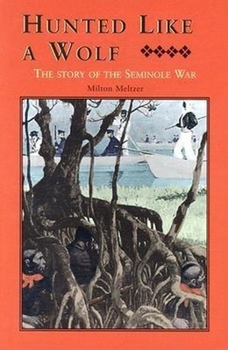Hunted Like a Wolf: The Story of the Seminole War
Select Format
Select Condition 
Book Overview
A landmark work on one of the most important but least-written-about Indian wars, Hunted Like a Wolf chronicles the Second Seminole War. From 1835 to 1842, Washington, D.C. waged a violent war upon... This description may be from another edition of this product.
Format:Hardcover
Language:English
ISBN:156164305X
ISBN13:9781561643059
Release Date:February 2004
Publisher:Pineapple Press
Length:183 Pages
Weight:0.98 lbs.
Dimensions:0.8" x 6.4" x 9.3"
Age Range:17 years and under
Grade Range:Preschool to Grade 12
Customer Reviews
2 ratings
A Good Popularized Account of the Seminole Wars
Published by Thriftbooks.com User , 16 years ago
Taken from the statement of Seminole chief Halleck Tustenuggee after his capture as he was being transported to Oklahoma Indian Territory in the west during the Second Seminole War, the title of this book perceptively captures the sense of the struggle between the Seminole and the Americans in the early years of our history. Florida, a territory that was under Spanish, then British, then Spanish dominion in the early days of our history, eventually fell to the newly minted United States when Andrew Jackson, the frontier Indian fighter and American military leader violated Spanish sovereignty in pursuit of Indians and escaped slaves of African descent who had taken refuge in the Spanish colony. Of course, Jackson was after more than just dealing a devastating blow to the Indians and their African allies. He wanted to grab Florida for the new nation whose frontier population was greedy for territory and considered Indian presence on such land irrelevant. In the course of his invasion (around 1817-1818), Jackson attacked and slaughtered the Indians on the Alachua Plain in northern Florida after having previously engineered the destruction of Fort Mose, run by a community of escaped black slaves on the Appalachicola River in the western Florida panhandle. As a result of his actions in what became known as the First Seminole War, the Indians and blacks fled south and east but, as a result, they lost their best lands and were pushed into a more marginal existence. Spain, seeing the handwriting on the wall with Jackson's invasion, decided the better part of valor was to sell out to the Americans and so Florida passed into the hands of the new nation to the north. As a result, there was a land rush from Georgia, Alabama and South Carolina as whites flooded in to take land and set up plantations relying on slave labor. Because the United States had banned the import of new slaves, though leaving the legality of slaveholding to the states themselves, the new settlers were as hungry for slave labor as they had been for land and the many hundreds of free blacks and blacks who were nominally the slaves of the Seminole (though Seminole slavery looks to have been fairly benign) promised a ready and profitable pool of new slaves. On the premise that even the free blacks in Florida had to have belonged to some white at some point, all the blacks who had sought refuge there in Spanish days were seen as fair game. It's the strength of Milton Meltzer's book that he shows, in decidedly unambiguous terms, how these dynamics led directly to the Second Seminole War in 1835. That war began because of the constant agitation of the newly arrived (and arriving) white settlers for land and slaves. When Jackson won the presidency in 1828, he pushed for the removal of the eastern Indians, seeing the passage of his Indian Removal Act by Congress in 1830. Jackson had previously defeated the Creek Indians of Georgia and Alabama in the Red Stick War and seized huge amounts of t
Tells of a desperate struggle by a vastly outnumbered people
Published by Thriftbooks.com User , 20 years ago
Drawing its title from a Seminole's leader words in 1842, "I have been hunted like a wolf and now I am about to be sent away like a dog", Hunted Like A Wolf: The Story Of The Seminole War is the riveting true account of the costliest of America's Indian Wars, in terms of both money and human life. Award-winning author Milton Meltzer tells of a desperate struggle by a vastly outnumbered people attempting to retain the land they lived upon. The Second Seminole War was also as much of war over slavery as it was over territory, for living among the Seminole were black men and women - some runaway slaves, some free - ready to lay their lives on the line for those they considered to be brothers. Thoroughly researched, and written in plain terms directly accessible to the lay reader, Hunted Like A Wolf examines not only the events of the war, but its legacy, and the motives of those who pushed so hard for it. Hunted Like A Wolf maintains as much impartiality as it can when describing lynchings, the raw greed for land, the desire to enslave black people, and the funneling of national wealth into the coffers of a state's private militia. In the end, Hunted Like A Wolf proclaims that the Seminole wars - which ultimately removed the vast majority of Seminoles from their ancestral lands, and instilled a pattern of ruthlessness that would poison American government for an era to come - stemmed directly from, in the words of American senators, "A continuous desire to exploit and expropriate Indian land and physical resources and a self-righteous intolerance of tribal communities and cultural differences." Highly recommended.






